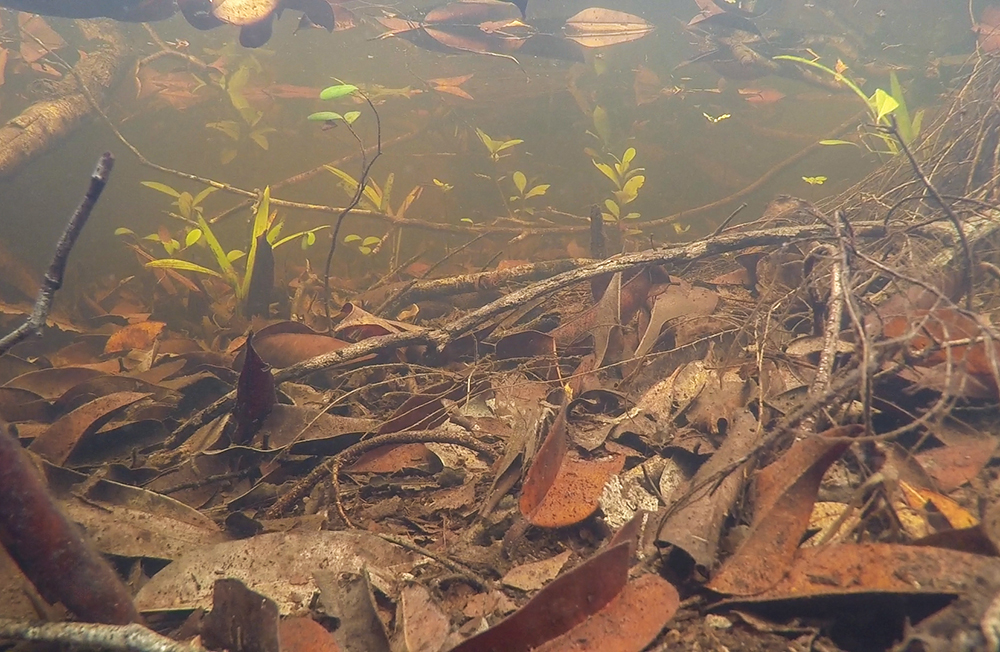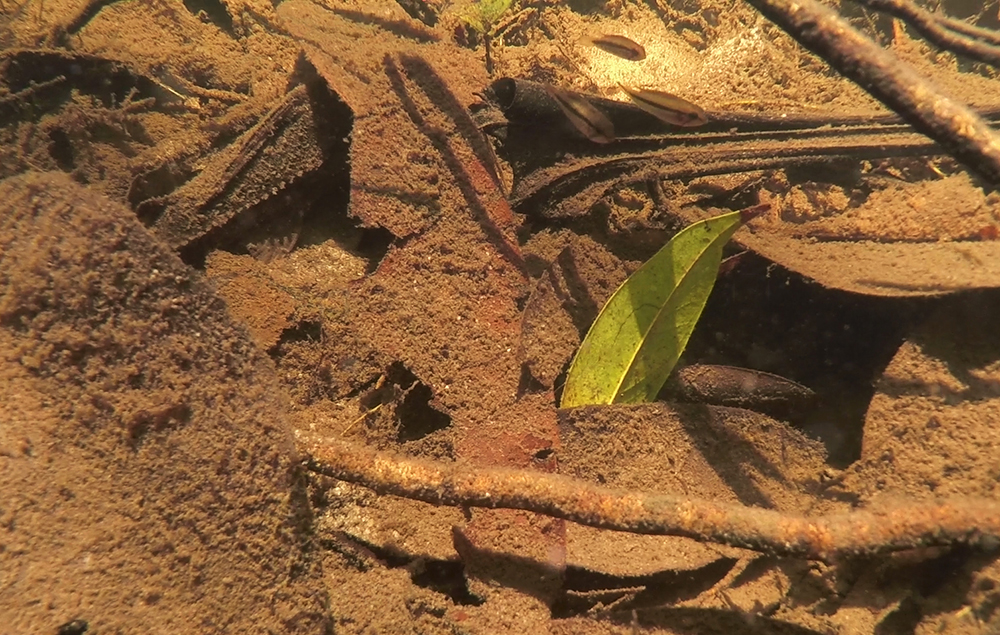
A leaf-litter-strewn blackwater habitat like this one is characteristic of the middle Rio Negro and home to a diverse group of fish species. (Still shot excerpt from video.)
Following up on my earlier video of a somewhat unusual, clear-water microhabitat along the lower Rio Negro, here is a collection of underwater footage filmed a few days’ travel upriver, in what would be considered “classic” blackwater habitat.
The Igarapé at Daracua, which I profiled in detail in the Jan/Feb issue of Amazonas, is closer to what most people imagine when they think of the warm, tannin-stained waters of many Amazon tributaries. It immediately offers inspirations for my future biotope aquarium aquascaping plans.
Here, in the shallows of a small area of flooded forest not far from the city of Barcelos, dozens of familiar species of aquarium fish can be found living among the tangle of roots and fallen branches. Perhaps the most recognizable of these—the Cardinal Tetra (Paracheirodon axelrodi)—takes center stage through much of this video, its unmistakable neon blues and reds contrasting strongly against the tea-colored water.
The scene at Igarapé do Daracua is representative of a wide range of shallow, blackwater habitat found throughout the Amazon and its tributaries—especially the Rio Negro in Brazil and the Orinoco in Colombia and Venezuela. The water, especially during the low water season, is warm (82-86F/28-30C), extremely acidic (as low as 3.5 pH in this particular habitat), and with almost no mineral content. It is rich in tannic and humic acids, both of which contribute to the characteristic dark brown coloration of the water. As is evident in the video, the water also carries a significant amount of particulate organic matter, which serves as a food source for many fish and invertebrates. Fallen branches, bark, seed pods, and a dense carpet of leaf litter line the bottom in areas close to the water’s edge, providing not only abundant shelter but also a rich source of detritus and biofilm for fish to graze on.
Although there has always been a niche group of hobbyists who went to great lengths to replicate this unique habitat in their aquaria (remember Blackwater Extract? It’s been around since the 1970’s), it is only somewhat recently that the “blackwater aquarium” has started to go mainstream. Today, it is easier than ever to keep blackwater species in a more natural environment with the availability of high quality driftwood, tannin-leaching Ketappa, or Indian Almond leaves, and an array of other interesting and functional accent pieces from specialty suppliers like Tannin Aquatics. In my opinion, this couldn’t come soon enough, given the fact that so many popular aquarium species are uniquely adapted for life within distinctive–some might say extreme–habitats like those featured in the video.
Given the sheer density and diversity of species encountered in just the few minutes of video footage, I won’t even attempt to identify every fish that makes an appearance. However, some of the highlights include the following:
- Cardinal Tetra (Paracheirodon axelrodi)
- One-lined Pencilfish (Nannostomus unifasciatus)
- Diptail or Eques Pencilfish (Nannostomus eques)
- Tailspot Tetra (Bryconops sp.)
- Goldline Tetra (Hemigrammus sp.)
- Saddled Cichlid (Aequidens tetramerus)
- Checkerboard Cichlid (Dicrossus filamentosus)
- Apistogramma sp.
See if you can spot them all, as well as a few hidden gems, like the brief appearance of a well-hidden talking catfish (Amblydoras sp.). And please feel free to point out anything we’ve missed in the comments. Be sure to watch the video in HD, and for more information on this and other Rio Negro biotopes check out the Jan/Feb issue of Amazonas Magazine. Enjoy!







Very nice video! Can someone tell me what the neat looking fish is at the 4:26 mark? Thanks
what is that tetra with the red eye?
Hemigrammus belottii
I think it is Hem. Bellottii
Yes, very likely Hemigrammus bellotti. Although I would not be surprised to see that one “species” split into a complex at some point.
Loved this Mike! Once again — I wish I was you. Great video. Watched it in HD as you suggested. Can we hook up via video link and do a Fincast on this dive?
Thanks John, by all means let’s do that. Email me and we can work out the details
What is a Goldline Tetra? Is it Hemigrammus rodwayi?
I was just wondering something. I’ve read in many articles, that the nitrifying bacteria won’t survive acid waters. So if I want to replicate this particular biotope, how would it be possible without affecting the nitrifying bacteria in the filter? Would the bacteria in the filter survive a ph of 3 or 4?
Also, the water in these biotopes are very calm with very low movement. In the aquarium world how can we achieve a healthy ecosystem without strong movement of water?? In order to keep a healthy tank I believe one of the most important aspects is to keep moving the water. Many unhealthy tanks can produce cyanobacteria precisely because the lack of water movement, so can we possible archive good results with slow water movements?
Thank you for any possible reply!
Many I have heard say that ammonia isn’t toxic in that low of ph, and there is no nitrite in that water since there is no nitrifying bacteria to make it. Here is an explanation of Fishlore, I had the same question and asked there:
https://www.fishlore.com/aquariumfishforum/threads/how-does-ph-work.487789/